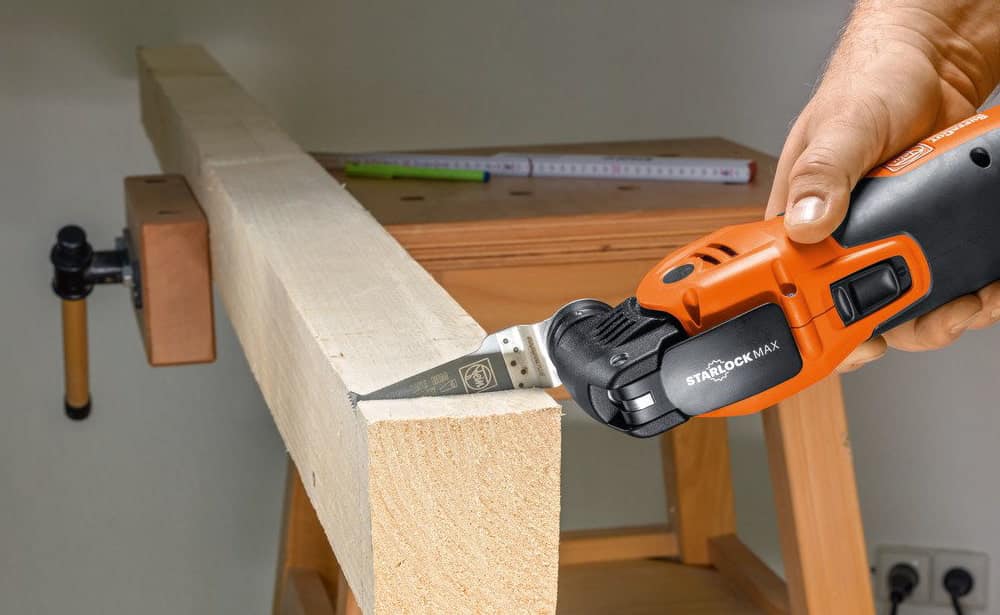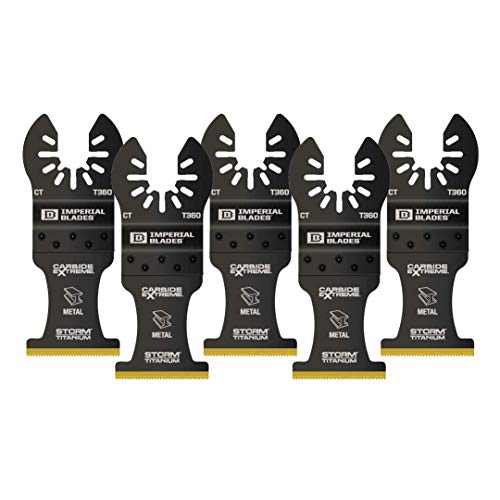How to Use an Oscillating Tool

An oscillating tool is one of the most multifunctional tools you can own whether you are working on a job site or in your home workshop. It is a tool that every professional and Do-it-Yourself homeowner should have in their toolbox. An oscillating tool's ability to be versatile allows you to do many jobs with ease that would normally take much longer if done without it. It not only speeds up your work, but it can accomplish jobs that simply can not be done at all with other larger and more awkward tools.
Oscillating tools allow you to sand, saw, create large holes, plunge cut into hardwood or undercut wood projects like doorways and tile. It is fantastic at removing grout, cutting trim for new floors, cutting off nails and screws to make them flush. The list for what this tool can do is extensive. These tools are extremely easy to operate and require very little instruction on how to use them. Most people can begin to do work that is high quality and satisfying to complete without the stress of having to haul out heavy-duty tools.
What is an Oscillating Tool?
An oscillating tool is a multifunction tool that can accomplish many tasks. Products range from the high-end Fein product at $650 to the more value priced Glaxa at $30. They all generally work with a side to side movement while oscillating at a very slight angle (approx. 3%) and at a very fast speed (21000 OPM). When using it, the motion of the tool feels like it is vibrating. It can be used with accessories such as blades, scrapers and sanding pads depending on the job you require it to do.
This tool is perfect for situations where there is little room to maneuver and larger tools will not fit. You can cut pipe that is in small places, cut out sections of wood where a router and saw will not work and make a quick work of jobs that really do not need major construction hardware. An oscillating tool can come with a variety of options, including cordless and plugin which can also help if you are in areas with little space or have little accessible power sources.
If your particular multitool comes with varying speeds, you can also learn to use that to your advantage. If you adjust the speed of the oscillating tools’ motion according to the job, you can get better operating performance and movement from it to accomplish what you need to. Once you have your speed set then you just plug the tool in or take it off the charger, press start and off you go.
You can use it for:
Plunge Cuts

A plunge cut is when you need to cut a shape inside material such as wood or drywall. There is no edge to start the cut on. This is one of the most problematic cuts you will have to deal with in any construction work. An oscillating tool makes these “impossible” cuts possible. The tool can create holes in drywall for electrical boxes, cut a mortise and tenon joints, make notches, cut trim for flooring and much more. The goal of plunge cuts is to cut the shape you need into the material without ruining the edges. An oscillating tool will give you a clean, measured cut without damaging surrounding material.
Basic Cuts
While plunge cuts are somewhat complicated, an oscillating tool for a basic cut is quick and easy. Rather than pull out on of your heavy-duty saws, an oscillating tool can make a clean and precise cut if you just need a little length or height adjustment or a bit cut off the edge of a cabinet or piece of trim. It is a little more difficult to create a clean straight edge cut but if you use a guide to keep the cut on the right track and its an easy way to accomplish the task you need to be done.
Small Detail Sander

An oscillating tool can take the place of other tools, saving time and money. One of those tools that can be replaced on certain jobs is an orbital sander. Remove the blade of the oscillating tool, put on the sanding attachment and it becomes a sander that can take care of small detail work. While the oscillating tool will not be a big enough replacement for large projects such as deck refinishing, it works great in small areas that need some finesse work such as around the rails or corners of steps. Its fairly small size allows control over the work and can also be used for the nit-picky jobs. The great thing about this small size is that the jobs it can do will include the removal of grout and glue which is always tricky.
Flush Cuts
This type of cut allows for cuts that allow the surrounding surface to stay unscathed. It offers quick flooring prep and the installation of trim as well. Using an oscillating tool for these projects makes them easy. You switch out the blade for a half-moon blade and then you can make long cuts in whatever material you need to use whether it be wood, drywall or metal. The half-moon blade offers you increased surface area allowing for a straight line when cutting quickly.
Nasty Jobs
Do you need to strip, peel or scrape? The literal pain of trying to remove old paint, a glued linoleum floor, the unknown gunk that your kids have left behind can all be dealt with by using an oscillating tool with a scraping blade. Whether you are trying to remove construction adhesive, joint compound or glue you can wear yourself out using an old putty knife to scrape things away. Switch your oscillating tool to the scraper blade and you can make quick work of the nasty stuff. You can buy multiple types of scraper blades: stiff or flexible, sharp or dull (blunt), straight or offset. Lots of options for lots of cleanup jobs.
Don’t Let Your Bathroom Scare You!
No matter how bad that bathroom has gotten, an oscillating tool will be a help. Remove grout and caulk with less mess and less stress. It takes a little bit of work to get the hang of removing bathroom sealants but once you do, you can take out this stuff out without damaging anything underneath. This tool will also help in reducing the dust you need to work in. You can get a carbide blade for small jobs and use a diamond blade for the larger ones. The diamond may be more money, but it will last much longer than the carbide. They come in various widths depending on what you want to use. Watch for sparks as you work away at your project. Once the sparks happen, its time for a new blade.
Dealing with Rusty Bolts and Nuts
Oscillating tools are great for these rough and awkward jobs. Once a nut is rusted into place, there are times that your WD40 and wrenches are not going to move them no matter how strong you are.
Reciprocating saws are almost impossible in small places so they will not help either, especially in areas such as under a sink or around a toilet. However, you may be able to remove the nuts with an oscillating tool with a high-quality bi-metal cutting blade. If you can angle the tool against the nut itself and start cutting very slowly to cut a groove you may have success. Increase the speed once the groove is cut and then saw until you are close to ¾ of the way through the nut. You can break off the remaining part with pliers. It takes a little bit of work but can save you some money and stress in the long run.
Trim the Shims
Installing a door is never just a simple install, there is always the need to work with some give and take. When you have to use shims, they can get finicky. Most will use a utility knife to score them and then break them off. This can be a problem because not only is it slow, but you end up moving the shims when you break them off and have to readjust everything. Uneven breakage can mean you start again as well. If you use your oscillating tool, it is just a quick, clean-cut and you are done. No fiddling around and no hassles.
Flexibility

Its obvious oscillating tools can be used in many ways in many variations; however, they can be adjusted further by using extra-wide blades. Using these types of blades means you can cut round products such as pipe as the tool will not slip off the curved surface the way other thinner blades can. Thinner blades are great for other jobs such as plunge cuts simply because they do these cuts with more ease and are easier on the motor but with extra blade options, you are able to tackle more jobs such as pipework.
Now What?
Now that you know how you can use this multipurpose tool in many applications, what attachments do you choose to work with? You need to be careful about brands. There are many accessories that are fairly interchangeable with multiple products so you can choose the product in the price range that works for your budget and then you choose what you need. If your sanding, then its like buying regular sandpaper. You need to look at grits, pads or needing something for smoothing projects down. The same type of analyzation needs to happen with blades and scrapers. What fits the tool you own? What price range are you looking at? And what do you need to tool to accomplish? All this will help you assess what will work well with your oscillating tool.
What Attachments do I Need for a Job?
If you’ve assessed what tool you own, the price range and the job you are working on, then you look at attachments. You need special blades to work at cutting wood or metal, cutting drywall, making flush cuts or pipe cuts. You will need specific scrapers if you are removing paint or caulking. These can vary between flexible and rigid. There are also grout remover blades if you are working on that particular job. There are lots of combination packs you can buy that cover many of these accessories. But be aware of how your particular tool works when it comes to changing out the parts. Some can use a lever or pressure system to swap out parts, but others need an Allen key or hex wrench which can be a little more problematic. Either way, you want to make sure you purchase the kit that is appropriate for your particular tool.
Final Thoughts
Using an oscillating tool for your work is simple and a great choice for many jobs that could be much more complicated if you are forced to use bigger and less agile tools. You can not only use an oscillating tool for those tough awkward jobs, but it can also help with those heavy-duty physical jobs as well. Rather than scraping away at glue or grout with a handheld scraper, the oscillating tool can take the strain off of your body and move you along efficiently to your job completion.
Once you find the oscillating tool that does what you want and fits your budget, your purchase will open the door to doing projects with ease and speed. Put the attachment on that you need, turn the tool on and start your job. It's not a complicated tool and its uses are extensive. An oscillating multitool should be placed in your toolbox next to your hammer and flathead screwdriver as it will become your every day go to from the most basic jobs to the most awkward.







